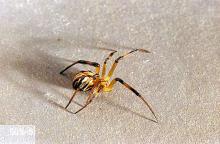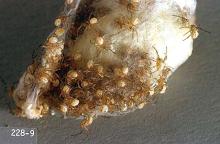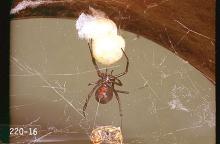Pest description and damage There is much confusion regarding poisonous spiders in the Pacific Northwest, even among the medical community. While all spiders use venom to subdue their prey (hence, all spiders are "venomous"), the bites of most spiders are often only mildly irritating. Only three spiders of medical importance live in the PNW. The black widow spider commonly occurs in association with humans and presents a real danger of poisonous bites. The other spiders of concern are two species of sac spiders in the genus Cheiracanthium. These are found frequently in houses, but few bites from these spiders in the PNW have been documented. A fourth spider, the hobo spider (or aggressive house spider), has long been blamed for spider bites but has now been exonerated: there is no scientific evidence that it produces necrotic bites.
Many spider bites reported in the PNW are attributed, unfortunately, to a spider that does not even live here, namely the brown recluse spider. While the bite of the hobo spider is similar (see below), the brown recluse spider does not naturally occur in the PNW. The only known cases of this spider have been linked to people moving into the PNW from areas of known infestation.
The following discussion will help differentiate these spiders:
1. Black widow spider
Latrodoctus spp.
Occurs in the PNW generally in dry, undisturbed areas such as firewood piles, old lumber, dry crawl spaces, bales of hay, etc. Black widows may be found in houses, under furniture, in dark corners, and amid stored items. Many believe black widows are found only east of the Cascade Mountains. They may also be found west of the Cascades, especially on dry, open, south-facing slopes. Black widows can be very abundant in southwest Oregon.
The adult female is 1.5 inches in diameter, including legs, and is jet black with red markings on the underside of her abdomen. Males and immatures may be striped white or yellow. This spider is secretive, not aggressive, and rarely causes bite injuries. The venom is neurotoxic and may lead to systemic effects, sometimes even death.
2. Yellow-legged sac spider
Cheiracanthium inclusum and C. mildei
Sac spiders occur throughout the U.S., commonly in dense vegetation. They are also well adapted for living indoors. The body of a full-grown spider is about 0.3 inch long and with legs extended to 0.75 inch. Color is generally yellowish but may be pale gray. There are no conspicuous markings and the body is covered with fine hairs. Legs are long and delicate. Eight eyes are arranged in two rows. They have long fangs and are capable of inflicting painful bites.
Reference: http://webdoc.agsci.colostate.edu/bspm/Arachnida%20%28Arachnids%29/Yellow-legged%20sac%20spiders.pdf
3. Hobo spider or aggressive house spider
Tegenaria agrestis
Commonly found in the PNW in and around houses, barns and sheds. It is a member of the funnel-web spider group. This is a relatively large spider (body size, excluding legs, 0.375 to 0.625 inch; 1 to 1.75 inches including legs) with long, hairy legs and chevron-shape abdominal markings. Despite the common name, "aggressive house spider," this spider is no more aggressive than others and reported bites from this are relatively rare. Until recently it was thought to be dangerously venomous, however, recent research indicates that the bites from this spider are no more dangerous than bites from most other spiders: the U.S. Centers for Disease Control (CDC) has removed it from its list of poisonous spiders.
4. Brown recluse spider
Loxosceles reclusa
This spider's range is confined to the south-central U.S. It is not found in the PNW. In the PNW, bites from hobo spiders are often erroneously attributed to the brown recluse. It is generally smaller than a hobo spider, is much less hairy, lacks the chevron markings on the abdomen, and most often has a distinctive violin-shape mark in the center of the thorax. Its venom is necrotic, causing wounds that may be slow to heal.
Management
Spider bites-what to do if bitten
If bitten by a spider, it is important to capture and preserve the specimen (preferably in rubbing alcohol) for identification. This information can be important in determining an effective treatment. The following steps are recommended after a bite:
Immediately apply an ice pack to the bite to reduce any swelling.
Sterilize the bite with hydrogen peroxide or iodine to prevent infection.
Most spider bites rarely cause more than localized redness and burning at the bite site. If serious symptoms develop, such as fever, nausea, stomach cramps, or ulceration of the bite, contact a physician immediately.
Further information on first aid for spider bites can be found at: http://www.mayoclinic.org/first-aid/first-aid-spider-bites/basics/art-20056618
Preventing spider bites
Many spider bites may be prevented by reducing the numbers of spiders near or in living areas. Black widows and hobo spiders both prefer dark, cluttered spaces, such as attics, garages, basements, crawl spaces, closets, storage areas, under and behind furniture, rocks and woodpiles, and foliage against exterior walls. Frequently cleaning house interiors and reducing clutter disrupts their shelters and exposes them for removal. Trimming foliage back from exterior walls removes outdoor shelters. When working in areas that may harbor these spiders, it is prudent to wear gloves, a heavy, long-sleeve shirt, long pants, and shoes or boots. A hat is also helpful in crawl spaces and when pruning foliage. Clothing stored for long periods in areas where spiders are likely to live should be vigorously shaken before wearing.
It is rarely useful to apply pesticides or fumigate a house to control or eliminate spider infestations. This should be considered only where infestations are extreme. Pesticides and fumigants do not provide long-term control. At most, only the local spider population is affected, and spiders from the surrounding areas will simply move in and take advantage of the "vacancies." Glue traps can reduce spider populations indoors if placed where spiders are frequently seen.
Contact from spiders in firewood-treatment and avoidance
While several products currently are registered for use on firewood, treating firewood is generally neither advisable nor necessary. Inhaling smoke from treated wood may be hazardous. The best approach to handling firewood or debris that may harbor poisonous spiders is to wear gloves and a heavy, long sleeved shirt. Check the firewood for spiders before bringing it into a residence-banging each piece on the ground beforehand will often dislodge any resident spiders. Burning firewood promptly will reduce the possibility that spiders will disperse into a residence or eggs will hatch.
For treatment of spider bites, the medical community is referred to: Wasserman, G.S. and P.C. Anderson, 1984, Loxoscelism and necrotic arachnidism, J. Tox. Clin. Tox. (1983-1984) 21:451-472.
For further information:
Spiders. Washington State Department of Health. https://doh.wa.gov/community-and-environment/pests/ticks





